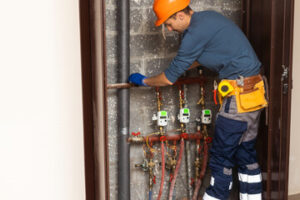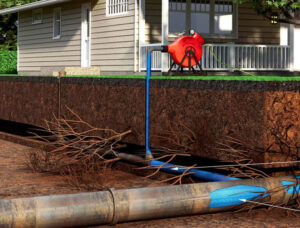Septic Tank Cleaning Perth keeps your home’s sewage system functioning properly. Without it, waste materials can back up inback-up your house and pose health risks for you and your family.
Septic tank cleaning involves using a large truck with a pump to remove liquid waste and solids from your septic tanks. The specialist will locate the septic tank, uncover its access lids (if not already exposed), inspect the tank for damage, measure sludge and scum layers, and pump and clean each compartment.

Septic tanks do not get much attention until something goes wrong, but routine cleaning can prevent a catastrophe. Solid wastes that build up in the tank can contaminate nearby water sources and soil. Getting rid of these wastes prevents them from leaking into your house and eliminates unpleasant odors.
During septic tank cleaning, the pros remove all sludge from the bottom of the septic tank. This process may take a couple of hours or more. They also stir up the contents of the septic tank to break up the solids, so they can be removed more easily. Septic tank cleaners also remove any clogs that could lead to sewage back-up in your home’s drain pipes. The clogs are removed with high-powered steam or a cable snake. In some cases, a septic tank can be clogged so badly that it cannot be pumped out. This can be avoided by avoiding flushing items that do not break down, including baby wipes, Q-tips, facial tissues, condoms, cigarette butts, and cat litter. In addition, use less water in your home. This includes using shorter periods of time to wash dishes and rinse laundry, reducing the number of loads per week, and limiting how long the water runs when washing hands or doing laundry.
The septic tank contents are then taken away for disposal. The sludge is typically sent to a local treatment plant. In some cases, the septic tank is recycled and used as a substitute for commercially produced fertilizer.
If you have noticed standing water or a strong odor coming from your drains, it is likely time to call for septic tank cleaning. A professional service will be able to inspect your septic system, recommend an appropriate pumping schedule, and provide the services you need to keep your home healthy.
While you can prevent septic tank clogs and other issues by taking precautions, there is no substitute for getting the tank pumped regularly. Contact a local septic tank cleaning company to schedule your next appointment. The service will involve a large tanker truck with vacuum equipment that removes all liquids and solids from the tank. They will also clean the lid and expose the inlet and outlet sides of the tank.
Clogs
When grease, oil and fats get poured down your drain, they eventually solidify inside your septic tank and the lines leading to and from it. When this happens, it restricts waste flow and causes clogs that can spill over into your yard or home. This is a serious health and environmental hazard.
Grease clogs are especially difficult to remove because the hot water from your sink usually isn’t strong enough to melt and break them up. Instead, you’ll need to use a professional sewer cleaning service that uses high-pressure water to blast the clog apart.
In addition, it’s important to avoid flushing non-biodegradable products down your drain or toilet. These can include items like wet wipes, feminine products and certain types of toilet paper that don’t break down easily. You can also get clogs by overusing your garbage disposal.
There are a few simple DIY techniques you can try to clear a clog in your septic line, including using a plunger or natural cleaners. However, if the clog persists or doesn’t go away with these methods, it may be time to call a septic professional.
Before you start working on a clogged septic system, make sure you have the right tools. You’ll need a gas mask, rubber gloves and safety goggles to protect yourself from any hazardous fumes that may escape during the process. You’ll also need a pry bar and a wooden pole or rod to push through the clog in the septic pipe. Additionally, a mechanical auger can help you reach a clog that’s located further down in the pipes.
Once the clog is cleared, place all of your tools in a bleach solution for five minutes to kill any remaining bacteria and clean them up. Then, dump the bleach solution into your septic tank, not down a drain. Replace the access lid to your septic tank and wash your hands well. Also, be sure to wash any clothes that you wore while working on the septic tank. This will prevent you from bringing home bacteria that can cause illness.
Stagnant Liquids
Septic tanks need to be regularly pumped out in order to keep the solid waste from building up and clogging your drain lines and leach field. It is not possible to avoid this altogether, but you can help reduce the frequency of septic tank pumping by avoiding non-biodegradable materials that enter your home’s plumbing. These items can include coffee grounds, cat litter, tampons, condoms, paper towels, dental floss, oily substances, paints and thinners, household cleaners, cigarette butts and other solid waste.
While the septic tank itself is not a biological treatment system, the bacteria inside it breaks down solid waste and makes it into gas to escape through the drain line into the absorption field or evaporation mound. As solids and liquids go into the septic tank, the usable space in the tank decreases. When the usable space gets too low, it is time for a septic tank cleaning.
It is recommended that you have your septic tank inspected and cleaned by a professional every one to two years. This will help you determine the best schedule for pumping and cleaning your septic tank. There are also a number of signs that can indicate when the septic tank needs to be cleaned, including sewage back-ups inside your home, slow drains or clogs, and pooling water near the septic tank or the drain field.
When it comes to septic tank cleaning, a professional should be used because the process can be dangerous if not done properly. A professional has the experience and tools to safely unearth a septic tank, remove all waste from the septic tank, and dispose of it correctly. This is a much safer and more efficient option than trying to clean the septic tank on your own, which could lead to damage to the tank or improper disposal of waste.
If you need to have your septic tank pumped or cleaned, contact CityWide Sewer & Drain. Our experienced septic tank pumping and cleaning specialists are available 24/7, 365 days a year to inspect, clean and service your Long Island septic system.
Odors
When a strong and foul smell is coming from your septic tank or from the ground around it, this can indicate an issue with the septic system. The smell is caused by gases such as hydrogen sulfide and methane. These gases are able to carry airborne bacteria that can lead to serious illnesses and even death in high concentrations. This is why septic tank odors are so unpleasant and something you want to deal with as soon as possible.
One of the most common reasons septic tanks smell is that they are too full and need to be pumped out. This is a simple solution that works and can eliminate the odour quickly. However, if the problem is not fixed right away, the odour will likely return. That is because the septic tank will not be properly treated and the waste in it will start to break down again.
Another cause of septic odours is that the tank is filled with items that should not be flushed down the drains. This includes fats, oils, hygiene products and other chemicals that can overload the septic system, clog pipes, or destroy or reduce the bacteria that are needed for proper digestion of waste. Ensure you are only flushing the three P’s (pee, poo and paper) and getting your septic tank pumped on a regular basis to avoid this issue.
Finally, a septic tank may smell due to blocked venting. The vents that allow sewage gas to escape from the tank can become clogged by untreatable solid wastes, rodents, small animals or frost. If this is the case, it is best to have a plumber inspect the septic tank and the plumbing venting to resolve the issue.
If the septic tank is located far from the home, the venting can also become clogged by vegetation or debris that grows over the top of the tank. In this case, it is possible to have a plumber extend the venting so it is closer to the house to help with odors. Using carbon filters on the vents can also help to absorb odors and reduce them.




